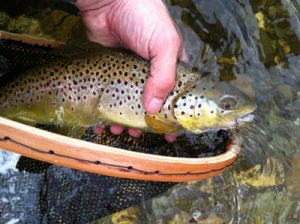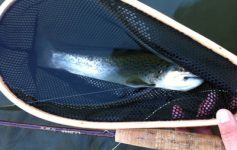While fishing last Saturday with a few friends, I realized what it is about fly fishing that is so captivating to me. In my opinion, it’s nothing like other types of fishing. There’s more steps, more stuff, and there is more of a challenge to fly fishing.
When most people think of fly fishing, they think of grandpa out on the river waving his rod back and forth causing the line to unroll behind him, then back in front of him before it falls to the water. And that is about as far as it goes.
When I think about fly fishing, it’s a whole other world out there..
I just started fly fishing last year, and before that I always loved catching fish. Whether is be on a worm, trolling a jig across a lake, or pulling Perch up through the ice, I’ve always had a thing for catching fish.
With these forms of fishing one could argue that the angler throws his bait in the water, and waits for a fish to bite it. Not too much different from fly fishing right? Wrong.
I prefer to fly fish for trout. Actually, I’m not really interested in catching any type of fish on a fly rod except trout. I think that trout are a beautiful fish with a wide variety of bright colors, spots and markings. I am also drawn to the habitats of trout. A small river meandering through a meadow, or a cold brook up in the mountains. A secluded pond deep in the woods, that hardly ever sees any human traffic. Oh, and they taste pretty good too.
You get to the stream, and you start to watch. Looking for spots that might hold trout. I go down the checklist of the amenities that trout require: cool water, shelter (cover), and food. Over there, beside that rock. Maybe down there, below that riffle. Oooh, look at that bank that’s been cut out by the current over the years!
Ok, so I know where the fish might be. Now, what are they eating this time of day, and at this point of the year? I’ll spend anywhere from 5 to 20 minutes watching the water, looking for bugs on and below the surface. Are the fish rising and feeding on the surface? Are they feeding below the surface? Are they feeding at all?
After I take a look at the water for a while, I can usually take a guess at what the fish are eating. Maybe I saw five winged bugs struggling on the surface. At the same time there could be hundreds of nymphs drifting by under the surface. Chances are better that they’re eating the nymphs and not the surface bugs. (There are more of them, they can be reached with less effort, and their location offers more protection from predators, like me.)
So now I that have a guess at what the trout are feeding on, I open my fly box(es) and try to find something with the same size, shape and color. I’m not too interested in entomology, and couldn’t tell you the difference between a stonefly and a mayfly. But I am observant, and can look at a bug on/in the water and pick something from my box that resembles it (somewhat).
So now I have a fly tied onto the end of my tippet. But what do the trout see when they are feeding? Surely the bugs aren’t streaking across the water at twice the pace of the stream itself.
Lets say I’m trying a nymph. The nymph that I am presenting to the fish needs to appear as natural as possible. Drifting down the current with no drag, with no unnatural forces acting on it. So I have to cast upstream, mend my line, and be careful to strip enough off to successfully set the hook should I get a bite.
What if I’m trying a dry fly? Again, the fly must be presented in a natural manner. It should fall gracefully to the water, stay afloat, and drift without drag. That last part is tricky. A slight change in the speed of the current, a breeze, or small riffle between you and your target are common problems. Maybe I should move downstream a little? Maybe I should hold my rod tip higher to keep more line off the water? Maybe my leader is too short?
If you can figure out where the fish are, what they are eating, and how to present your artificial fly to them in a natural fashion, you know how to fly fish. You don’t need to be able to execute a perfect roll cast. You don’t need to be able to shoot 30 feet of line. You have to solve the puzzle. And once you have, you need to hook the fish.
Hooking and landing the trout is only a very small portion of my fly fishing experience. I enjoy the game. Especially the fact that it starts over every time you hit the stream, river or lake. Or even before that, when you’re searching for the next spot that might hold trout.
I caught this nice Brown Trout over the weekend. After I failed to naturally present dry flies to a fish that I just knew was waiting for a meal, I headed downstream and started the game over again. Tied on a Prince nymph, cast upstream into a riffle a few times waiting for that (somewhat) familiar tug at the end of my line. When it came, I set the hook and landed this beauty.



